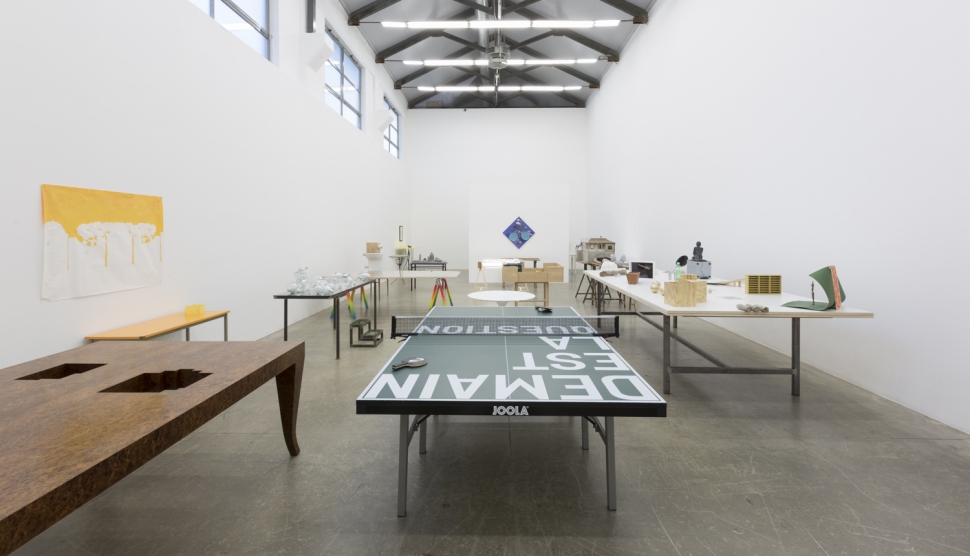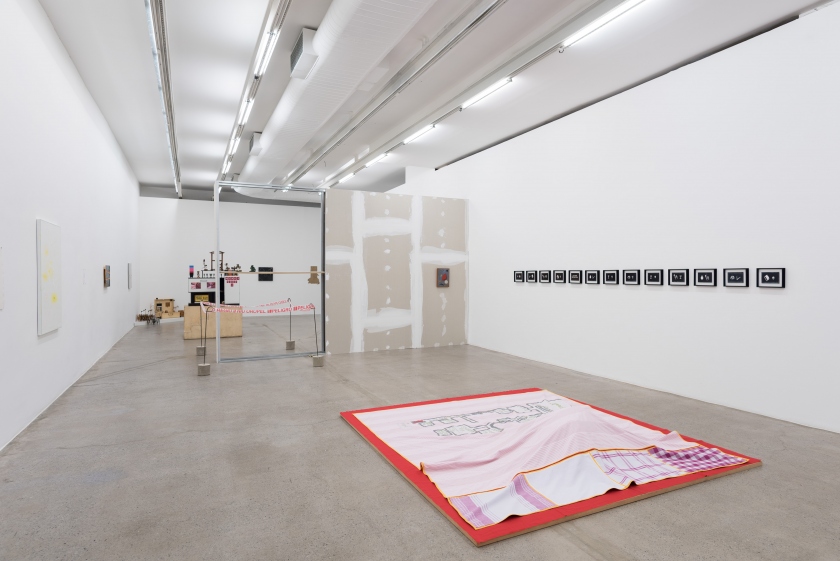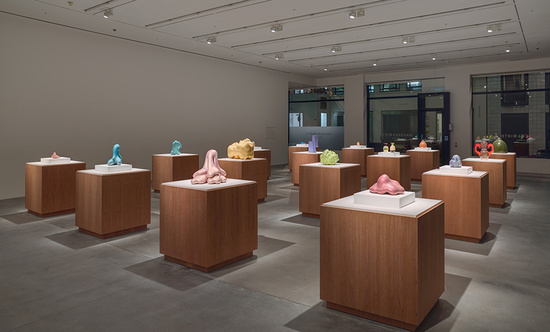On Curated Shows in Commercial Galleries
 The Pagad, 2016, installation view, Massimo De Carlo, Milan
The Pagad, 2016, installation view, Massimo De Carlo, Milan
It’s January 2016. I’m at Massimo De Carlo’s, in Milan. THE PAGAD strokes me with a sense of completeness, perfection and solidity. Probably one of the most interesting show I have seen in my city so far, with brilliantly selected works from the gallery’s archive.
An expanse assemblage of artists’ tables drives the way of a brilliantly staged exhibition, thematically and conceptually centred within the field of constructions that fall outside their utilitarian nature.
The universe constructed by Rita Selvaggio – the curator – reflects on the essence of the art-object, exploring the detachment of the functional element from the most basic, traditional domestic structure: the table.
I am writing these lines having the image of that Rirkrit Tiravanija locked in my mind, a work connecting the act of dialoguing to a basic representation of a sort of conversational sport as table tennis may be, structured through a tit-for-tat schema.
In my mind it is so clear, so natural: the curator worked with omni-comprehensive intellect to produce a language of semi-objects, refusing the idea of easy, safe zone proper to most of gallery shows happening around the globe.
The gallery functioned as archive, as a collection, in its purest aim to present works from represented artists in an anthological way. And that led me to reconfigure my opinion toward curated interventions into commercial galleries.
 Homo Ludens, 2016, installation view, Galeria Luisa Strina, Sao Paulo.
Homo Ludens, 2016, installation view, Galeria Luisa Strina, Sao Paulo.
It’s September 2016. I’m in Sao Paulo, Brazil. I am walking through the palm trees disseminated over the boardwalks of the neighbourhood of Jardims. Luisa Strina gallery is one of the highlights of my tour. The text of Homo Ludens is written in first person, as the text I am trying to write without being too emotional towards this astonishing, poetic show curated by Ricardo Sardenberg. The outside world is present in the room, the outside atmosphere seeps in through the relations created between the works on show.
It is real. No fiction. Fiction does not have to deal with dream. It is not necessary to link magical, oneiric experiences with factual evidence. And this group show testimonies how the concept of game may reveal the deepest implications of contemporary events. Rather than an exhibition, Homo Ludens is a beach volley match at sunset between the artists involved, is the convergence of irrationality and nasty surprise into a magnetic container of iridescent truth.
The interaction between the works is not influenced by thematic organization, but it is constituted by a non-linear exchange of experience, allowing the works to attract each other.
No reason, this is a museum show, as many you can see around Sao Paulo’s galleries. It is impressive how galleries here try to deliver a high-class offer, maybe without the worries of the economic feedback.
 Installation view, 'Ken Price. A Study of Sculptures and Drawings, 1959 – 2006', Hauser & Wirth London
Installation view, 'Ken Price. A Study of Sculptures and Drawings, 1959 – 2006', Hauser & Wirth London
Photo: Alex Delfanne
It’s December 2016. I am in London. I am moving here, I have to find a flat very quickly, and actually it is a real struggle, waste of vital energies, I am exhausted. Even if I am running up and down around Hackney I pop into Mayfair quite late, at 5.30pm. Hauser&Wirth closes at 6.00, I’m in a terrible hurry.
At the moment I am frightened to death to write this paragraph, I will go gentle in that good night. - Will go short here.
A Survey of Sculptures and Drawings, 1959 – 2006 by Ken Price is a retrospective, a historical, punctual analysis of the work of the American artist. It would sound obvious and tediously insolent to state any word on Price’s work, I will not do it. The space is empty; the gallery staff is packing to leave after a workday. I’m here, it is magical, seriously. I don’t want to leave.
I can see how all the artists involved in plastic creation might have learned so much just seeing a picture of any of Price’s works. I can see music, I can hear William S. Burroughs.
I am going too mystical, but the sexual allure is real.
I think Hauser&Wirth is the first and only commercial gallery to have an in-house curator. Actually, Paul Schimmel is also Partner and Vice-President. At the moment, I am a bit confused concerning the structural differences between this gallery and any middle-sized institution in terms of quality of the program. If I would have the chance to have a second life, I would definitely be Iwan Wirth.
It turns out that holding a BA and, subsequently, an MA from any of the Ivy League art schools around the western world makes you a real curator. The legend narrates that defining ourselves as curators is a prerogative for personalities working with collections, displays, and assemblages of artworks. But the museum collection is no longer the appointed space for curators, both due to the multitude of professionals working within the field, and due to the urgency of differentiating the outputs of a non-standard curatorial practice.
I can feel the necessity of finding different channels for the curatorial activity.
In my life, although short in its duration, I have seen curated biennales, curated exhibitions, curated project-room exhibitions, curated panels, curated public programmes, curated educational programmes, curated fashion collections, curated playlists, curated clubnights, curated magazines, curated shop windows, and I am pretty sure I will have the time to see any other curated things.
This is not criticism toward over professionalism, and neither is scepticism in understanding how the role of the curator is transforming.
In a way, we are all there, sitting in front of the laptop, exulting for every line added to the CV. And at the end of the day, we have to apply for calls, proposals and everything else, and hopefully get an honorarium for that.
It is simple, if a curator cannot work with a collection or with a selected group of artists and art works, it appears obvious that he has to find the space to work.
I am perfectly conscious of the difficulties of practicing as a contemporary art curator, but on the other hand I feel sincerely worried about how much 2010s contemporary art panorama is totally based on legitimation, meaning the identification of a certain actor as established, relevant in a specific field of action. Thus, the process of name-circulation becomes more important than the actual coherence and strength of a curatorial statement.
Everyday I wake up and check magazines, web magazines, blogs, Facebook accounts, as do you. I see curators basically specialising in curating gallery shows. Generally they have a fixed roster of artists, or a fixed aesthetic canon they propose from gallery to gallery. I could close my eyes and spot who curated this and that show. They travel, they attend gallery dinners, they curate art fairs booths. Do they have a fee on gallery sales? Do they earn a percentage when an artist from their clique goes into a collection? I don’t know- I don’t know any of them.
I am writing this to investigate how the traditional role of the curator, intended as a sort of mediator between the artist and the public, has been slightly converted into a professional figure dealing with trends and economic success of contemporary artworks.
And trust me, I don’t want the art world to be a bed of roses, a place in which unicorns collect contemporary art and curators fly over carpets in search of hidden treasures.
I understand money and I understand name circulation. I worked in a major gallery for a year. I paid rent.
I was talking with a friend. He is a designer, writer and theorist of communication. He does not do logos, he works in avant-garde advertising, he pays the bills.
“Is it possible that curators could only practise in an institutional way only if employed in a museum, foundation, kunsthalle and so on?” – this was the question he was moving.
Nice one. I can’t answer.
I frequently tend to think ad absurdum. Pushing the limits of the subject over the reasonable line. That question drove me mad. I confess I tried to formulate several answers.
Here is a funny one: the gallery should be fluid. The gallery should represent curators, writers, thinkers, composers. No stakes on sales, no fees on commissions, no guidance on the curatorial line, just identity affinity to a certain reflection, research and practice. In that way the gallery may work for the curators’ benefit, providing exhibitions to work on, catalogues to write in, panels to moderate and so on. Curators could work with gallery artists within the gallery walls without any conflict of interest. They could also freelance for institutions and magazines.
I am thinking about this model while having a couch chatting with my friend, so please take it into your consideration.
I am not an institutional curator or writer.
In a world in which every gesture can become political, in which a curator is fired from its institutional position “for featuring Jewish-Polish relations too prominently, promoting the “culture of shame” rather than Polish self-respect”, it is necessary to reflect on what curating means. And “reflecting” does not necessarily means writing academic papers, longform articles, apologetic essays and so on.
We do need tangible statements and institutional support to avoid the bias of curatorial omni-presence and auto-referentiality.
There’s no need to dictate a general manifesto, neither is important to blindly protect the curatorial activity from the commercial sector. We do not need curatorial integralism.
No moral conclusion. Not giving anyone any good lecture here.